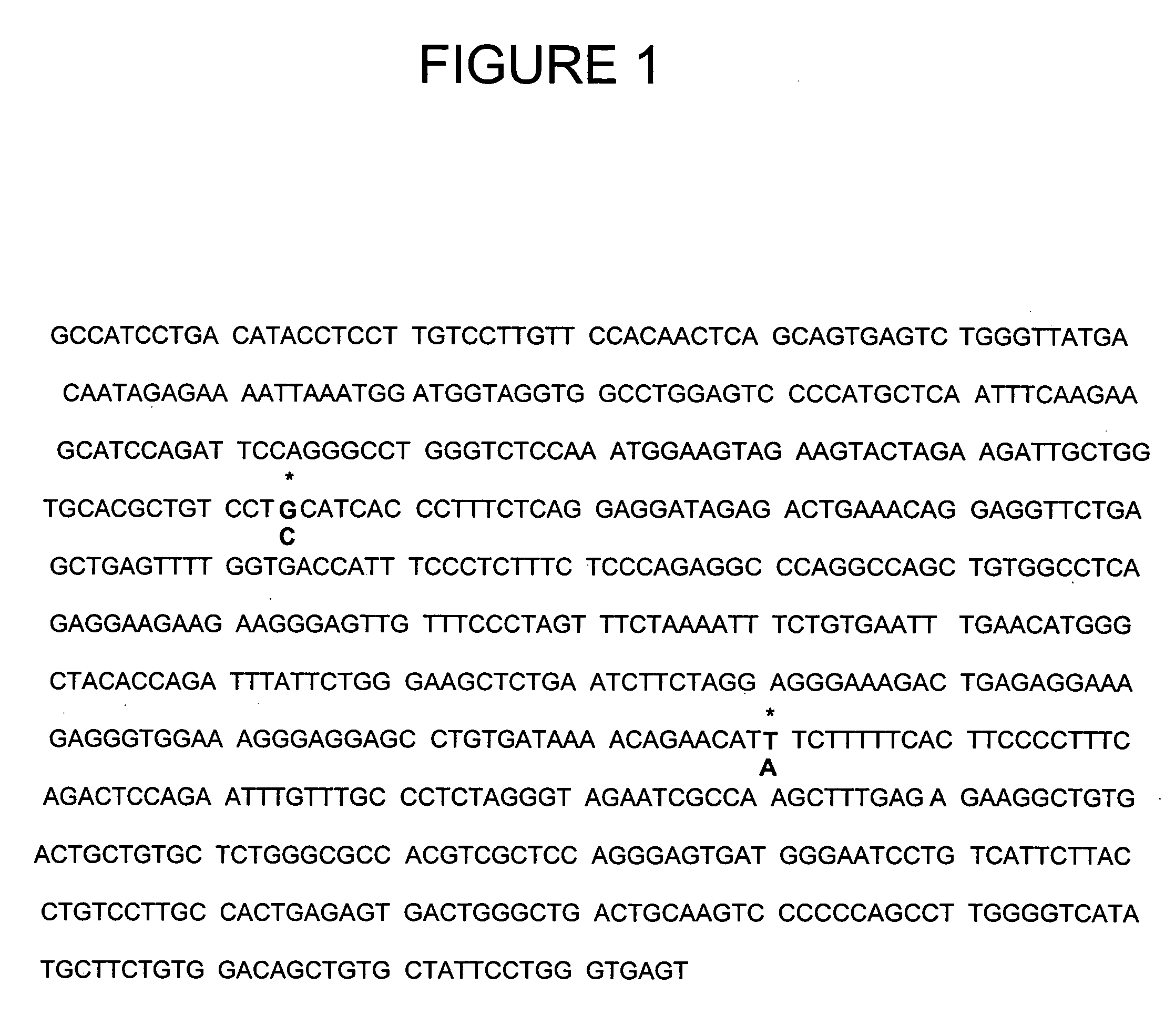Human FcgammaRIIB gene polymorphisms for assessing development of systemic lupus erythematosus and compositions for use thereof
a technology of fcgammariib and fcgammariib, which is applied in the field of genetic polymorphisms and polymorphism patterns useful, can solve the problems of difficult diagnosis of lupus, no single laboratory test that can definitively detect lupus, and serious and life-threatening problems
- Summary
- Abstract
- Description
- Claims
- Application Information
AI Technical Summary
Benefits of technology
Problems solved by technology
Method used
Image
Examples
example 1
Identification of Polymorphic positions in Human Genes Encoding FcγRIIB Associated with SLE
A. Identification of Polymorphic Positions
[0120] The following studies were performed to identify polymorphic residues within the genes encoding human FcγRIIB.
[0121] A 536 bp region of the 5′ untranslated region (5′ UTR) (SEQ ID NO: 1) of the human FcγRIIB gene in over 300 donors was sequenced.
[0122] Genotyping by polymerase chain reaction (PCR) followed by dye primer sequence analysis was performed. The FcγRIIB promoter was amplified using the following primers: forward primer 5′-ACATACCTCCTTGTCCTTGTT-3′ (SEQ ID NO: 2) and reverse primer 5′-CAGCCCAGTCACTCTCAGT-3′ (SEQ ID NO: 3) to produce amplicons of about 800 bp. The primers for forward dye primer sequencing had the M13 tag linked to the 5′ end of the forward primer 5′-TGT AAA ACG GCC AGT ACA TAC CTC CTT GTC CTT GTT 3′ (SEQ ID NO: 4); reverse primer 5′ GCA GTC AGC CCA GTC ACT CTC AGT (SEQ ID NO:5). Primers for reverse sequencing had M1...
example 2
Polymorphisms and Differential Promoter Activity of Human FcγRIIB
[0132] The biological activity of the FcγRIIB promoter allelic polymorphisms was studied in a reporter construct assay to determine whether the polymorphisms result in differential promoter activity.
[0133] Described regulatory elements of the FcγRIIB genes are located in the promoter region located upstream of the transcription initiation site. The regulation of gene transcription by gamma interferon (INF-g), a prototypic Th1 cytokine, is mediated by a promoter sequence 5′-TTCNNGGAA-3′ (SEQ ID NO: 8) with the potential to bind STAT1. Several STAT binding sites are present in the promoter of human FcγRIIB genes. A similar 9-bp consensus sequence 5′-TTCNNNGAA-3′ (SEQ ID NO:9) is a potential STAT 6 binding site, which is preferentially activated by IL-4, a TH2 cytokine. A glucocorticoid response element (GRE) required for binding of the glucocorticoid receptor DNA-binding domain is present in the promoter of FcγRIIB gen...
example 3
Polymorphisms in the Promoter of FcγRIIB and Relative Expression and Function of FcγRIIB in Primary Monocytes and B Cells
[0139] Studies were performed to determine whether there was a correlation between specific promoter alleles and levels of FcγRIIB expression in peripheral blood monocytes and B cells.
Real Time PCR
[0140] Total RNA was extracted from monocytes, purified by CD14 positive selection, using TRIzol reagent (Life Technologies) and reverse transcribed with the SuperScript Preamplification System (Life Technologies), all according to manufacturer instructions. For FcγRIIB transcript expression, real time RT-PCR assay was used. The SYBR Green PCR Core Reagents kit (PE Biosystems) was used with the iQ Multi-Color Real Time PCR Detection System (Bio-Rad) to amplify FcγRIIB1, and FcγRIIB2 in samples of cDNA derived from monocytes. The real time PCR reaction consisted of 45 cycles of 94° C. for 20min. and 53° C. for 20 min. Primers pairs were designed specifically for FcγRI...
PUM
| Property | Measurement | Unit |
|---|---|---|
| Tm | aaaaa | aaaaa |
| Tm | aaaaa | aaaaa |
| Tm | aaaaa | aaaaa |
Abstract
Description
Claims
Application Information
 Login to View More
Login to View More - R&D
- Intellectual Property
- Life Sciences
- Materials
- Tech Scout
- Unparalleled Data Quality
- Higher Quality Content
- 60% Fewer Hallucinations
Browse by: Latest US Patents, China's latest patents, Technical Efficacy Thesaurus, Application Domain, Technology Topic, Popular Technical Reports.
© 2025 PatSnap. All rights reserved.Legal|Privacy policy|Modern Slavery Act Transparency Statement|Sitemap|About US| Contact US: help@patsnap.com

